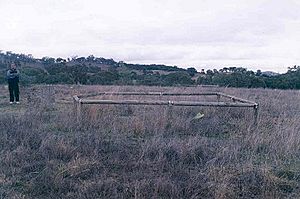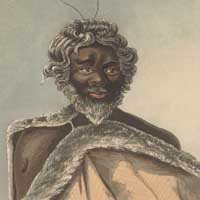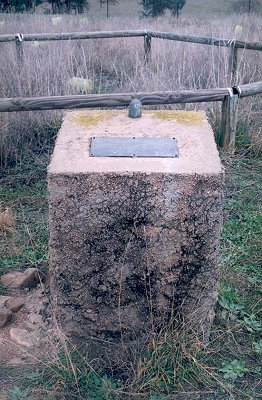Grave of Windradyne facts for kids
Quick facts for kids Grave of Windradyne |
|
|---|---|

Grave of Windradyne
|
|
| Location | Brucedale, 1361 Sofala Road, Sofala, Bathurst Region, New South Wales, Australia |
| Built | 1835–1835 |
| Architect | Wiradjuri people |
| Official name: Grave of Windradyne; Windradyne's Grave | |
| Type | state heritage (archaeological-terrestrial) |
| Designated | 10 March 2006 |
| Reference no. | 1714 |
| Type | Burial |
| Category | Aboriginal |
| Builders | Wiradjuri people |
| Lua error in Module:Location_map at line 420: attempt to index field 'wikibase' (a nil value). | |
The Grave of Windradyne is a special historical site located at Brucedale, near Sofala, in the Bathurst Region of New South Wales, Australia. It is the burial place of Windradyne, a famous Aboriginal warrior and leader. The Wiradjuri people built this grave in 1835. It is also known as Windradyne's Grave. This important site was added to the New South Wales State Heritage Register on 10 March 2006.
The Story of Windradyne
Windradyne was a brave warrior and a respected leader of the Wiradjuri people. His home was near Bathurst. He became known for his efforts to protect his people and their land.
Windradyne formed a special friendship with William Suttor. William's father, George Suttor, had moved to the area in 1822. He started a farm called "Brucedale." During the early days of European settlement, there were many conflicts. These clashes are sometimes called the frontier wars.
Sadly, a terrible event happened to Windradyne's family. This led him to declare war on the settlers. William Suttor had learned the local Wiradjuri language. He talked with Windradyne at the Brucedale farm. Their conversation helped calm the situation there.
Windradyne and William Suttor remained friends. When Windradyne passed away, he was buried on the Brucedale property. In 1955, the Bathurst Historical Society marked his grave. Today, local Wiradjuri people still honor the site. They have even planted trees around the grave in a traditional diamond shape.
Windradyne's Appearance and Skills
Windradyne was described as a very handsome young man. He had a strong build with broad shoulders. His skin was dark brown, and he had thick, black curly hair. He often wore a headband. His long beard was braided into three sections.
Windradyne was an amazing hunter. He was also a fierce warrior. Because of his great fighting skills, he was known as a powerful leader throughout the region.
Early Conflicts and Windradyne's Capture
The first European explorer to enter Wiradjuri country was Evans in November 1813. The first major attack led by Windradyne happened in early 1822. Settlers in Bathurst were very upset when Aboriginal people attacked their livestock. They asked for military help to protect them.
Major James Morisset sent soldiers to capture as many Aboriginal people as possible. He wanted to "teach these blacks a lesson." Windradyne learned about the soldiers' plan. To prevent harm to his people, he bravely walked out to meet the soldiers.
When the soldiers saw Windradyne, they quickly grabbed him. But Windradyne was so strong that six soldiers struggled to hold him. They even broke a musket over his ribs. Windradyne was then chained and taken to Bathurst. The Sydney Gazette newspaper reported his capture on 8 January 1824. Windradyne was sentenced to one month in prison. White settlers sometimes called him "Saturday."
The Turning Point: A Family Tragedy
A key moment for Windradyne occurred in May 1824 near Kelso. His family was passing a potato garden near the river. A settler offered them potatoes, which they happily took. The next morning, they took more potatoes from the same garden. This time, the settler and his neighbors ran towards them, firing guns.
This attack surprised Windradyne. He had no time to react. The Wiradjuri people believed in sharing their land and its resources. They expected others to share too. They had allowed the settler to grow his crops. But this settler shared one day and then attacked them the next.
The attack on his family was the final straw for Windradyne. He decided to seek justice under Wiradjuri law. This event started what became known as the Bathurst War. He gathered his people and asked them to join him in fighting back. The warriors prepared themselves. They painted their faces and bodies with ochre. They marked their shields and boomerangs with symbols of their totems.
That night, the warriors, led by Windradyne, began their fight for justice. The first white person they met was a man named Suttor. He had often been kind to the Koori people. Suttor's son later described this meeting:
"The Aboriginal people were causing trouble in Bathurst back then. This was often because of how badly the white people treated them... It's no wonder they fought back. One day, our hut was surrounded by many Aboriginal people. They were ready for war, led by their great chief, called "Saturday" by the white people. We couldn't fight back. So my father, who was eighteen, bravely met them at the door. He spoke to them in their language. He made sure they didn't think he expected any trouble from them.
"They stood there, serious and quiet. My father's cheerful courage and friendly voice calmed their anger. They talked quietly among themselves. Then they left as quickly as they came. The next thing we knew, they had killed all the men at a settler's place a few miles away. This was the place where it was rumored poisoned bread had been left for them. This place is still called "Murdering Hut" today... They never harmed my father or his animals. He had shown himself to be their friend before. But if he had shown distrust or anger this time, they would have surely killed him."
Windradyne could have easily taken Suttor's life that night, but he spared him. Suttor had never harmed the Wiradjuri people. The warriors were not killing people randomly. They were only seeking justice against those who had murdered their people, following Wiradjuri law. The attack Suttor mentioned happened at Millah-Murrah on 24 May 1824.
Windradyne and his warriors quietly surrounded the hut of Samuel Terry. Terry was a man who had left out poisoned food. He had also built his hut on their sacred Burbung ground. The warriors attacked Terry and his men quickly. Terry was speared six times, and his hut was burned down. They also killed his sheep and cattle.
Uniting the Wiradjuri People
Windradyne sent messengers to nearby areas. They spread the news of what was happening in the Bathurst region. Wiradjuri people from other districts knew their brothers and sisters needed help. Together, they would fight to drive their common enemy from the land.
Warriors from surrounding areas came to help Windradyne. Soon, about 600 warriors had joined him. With "Old Bull" from the south and "Blucher" from the northwest, Windradyne held a war council. They planned their next attack against the invaders.
A Plea for Peace
Windradyne decided to go directly to the government. It was a tradition for the Governor to invite all Koori people to a feast. This feast happened at the marketplace in Parramatta at the end of each year. It was supposed to honor them.
Windradyne gathered his remaining people. Together, they traveled over 194 kilometers to Parramatta. They arrived on 28 December 1824. His arrival at the gathering caused a big stir. He walked tall and proud, with the word "peace" on his hat. He knew the soldiers could not touch him. So many Koori people were there for the feast. If the soldiers tried to arrest him, it would have caused a riot right at the Governor's doorstep.
Windradyne announced he wanted to see the Governor. Windradyne tried to stop the killing of his people. He went to the Governor to "make friends." He wanted to make friends with people who had invaded his lands. They had stolen his country. They had killed hundreds of his people. He wanted to make friends with this group of people who seemed to care only about their own desires.
In a report to Earl Bathurst, Governor Brisbane wrote: "I am very happy to tell Your Lordship that Saturday, their great and most warlike chief, has come to me to receive his pardon. He, along with most of his tribe, attended the Annual Conference."
Windradyne's Final Days
Windradyne died in 1835. He had been wounded in a fight. He was taken to the Bathurst District Hospital. But Windradyne could not stand being confined again. He tore off his bandages and returned to his people. He camped on the property that was known as Brucedale. He died when his wounds became infected.
Windradyne was given a traditional Wiradjuri burial by his people at sunrise. He was placed sitting up, facing the rising sun. He was wrapped in his possum skin cloak. All his weapons were placed beside him. There was great sadness at the loss of their mighty warrior. Many Koori people gathered to say goodbye to Windradyne. Several trees were carved to mark the grave. These carved trees were meant to be a living memorial. The Koori people did not return to his burial place until twelve months had passed.
The Grave Site Today
The grave site is in a paddock on the "Brucedale" property. It is in the northwest corner. The National Parks and Wildlife Service has put up a protective fence around it. Inside the fenced area, there are remains of two grave sites. The other grave's identity is unknown.
In front of Windradyne's grave, there is a stone pillar. It has a plaque and a stone axe head in its center. Some new trees have been planted within the fence in a diamond shape. There are no longer any remains of the carved trees that were mentioned in historical records.
In 2000, the National Parks and Wildlife Service carried out conservation work. This included building the boundary fence around the grave sites.
Why This Site is Important
The site of Windradyne's Grave is very important to the history of New South Wales. Windradyne was a warrior of the Wiradjuri people. He was a key leader during the frontier war period. When his family was harmed, he declared war on the settlers.
He received a traditional burial with all his weapons. His grave was marked with carved trees. The Bathurst Historical Society recognized its importance in 1955. They put up a plaque in Windradyne's honor. Today, the Wiradjuri people still honor him as a special warrior. The site also shows the connection between Windradyne and the Suttor family settlers of Bathurst.
The Grave of Windradyne was added to the New South Wales State Heritage Register on 10 March 2006. It met several important criteria:
Historical Significance
This place is important because it shows the path of cultural history in New South Wales. Windradyne is linked to the frontier war. His grave is still respected by local Wiradjuri people today. It also tells a story of contact between the local Wiradjuri and the Suttor family.
Association with Important People
This place has a strong connection to a person important in New South Wales history. Windradyne is linked to a major event in Australia's settlement: the frontier war. His grave is still honored by the local Wiradjuri people today. It also represents a story of interaction between the Wiradjuri and the Suttor family.
Social, Cultural, or Spiritual Importance
This place has a strong connection with the Wiradjuri nation. His grave is still recognized and respected by Aboriginal people, especially the Wiradjuri, as a warrior's resting place.
Potential for Future Learning
Windradyne's Grave can provide information that helps us understand the cultural history of New South Wales. It offers insights into the frontier war fought between Aboriginal groups and settlers in Western NSW.
Example of Cultural Places
Windradyne's Grave is a good example of a contemporary Aboriginal burial site. It is also one of the only marked burials of a warrior in Wiradjuri country.



